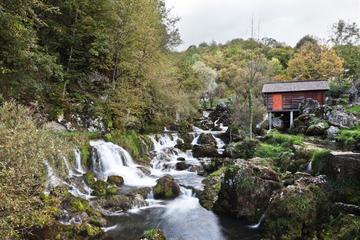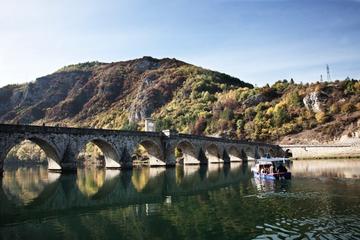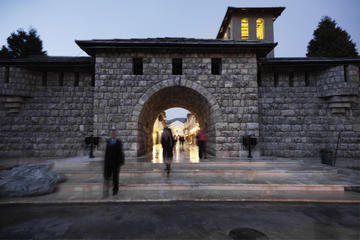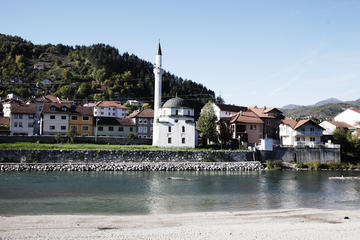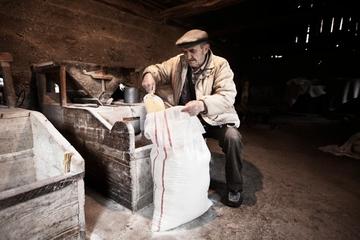
On the banks of the artificial Jablanica lake (photo Federico Sutera)
Bosnia Herzegovina is one of the European countries with the richest water resources. Projects to build a series of hydroelectric power stations in Republika Srpska, however, are endangering a delicate environmental balance. Report
“In 2004 the government of Republika Srpska awarded a contract for the construction of two dams on the river Vrbas, a few kilometres from Banja Luka. We started a protest, forming a coalition against the project. Since then 8 years have passed and, also thanks to our mobilization, the dams have not yet been built.”
Miodrag Dakić, of the Banja Luka Centre for the Environment , remembers one of the more successful civic battles in the recent history of Bosnia Herzegovina. The victory of the environmentalists could soon, however, be called into question.
The Republika Srpska, RS, one of the two entities which, on the basis of the Dayton Peace Agreement, make up Bosnia Herzegovina, has now been governed for almost 10 years with little interruption by Milorad Dodik, the present President and leader of the SNSD party.
During these years, the RS has transferred ownership of its precious assets to Serbia (Telekom Srpske), Russian business groups (Zarubezhneft, which bought the petroleum refinery at Brod and Yuzhuralzoloto, which has the Sase mine at Srebrenica) and global corporations (Arcelor Mittal, owner of the Liubija and Omarska mines at Prijedor).
Energy – in particular the granting of river sections for building dams - seems to be the most recent strategy for attracting foreign capital. The story of the contracts for the dams on the river Vrbas, however, shows that not all takes place transparently.
“The contract was won by a Serbian firm, the Građevinar d.o.o. of Kraljevo, in consortium with other smaller firms, none of which had any experience in building dams,” Dakić recalls.
“Immediately after winning the contract, Građevinar sold 95% of the building rights to a Slovenian firm, Viaduct of Portorož. The Slovenians subsequently transferred 79% of the established rights to Messerschmitt BB, a large German firm which today holds the majority in the concession.”
As it turns out, the right to exploit the water has already been sold several times, but a single brick has yet to be laid. “The consortium led by the German Messerschmitt,” Dakić continues, “has now set up a local firm to run the project, HES Vrbas . They hold the rights for 30 years, extendable to 50.”
The environmentalist maintains that the construction of these dams would be a profitable deal for the builder, but a disaster for the local community. “A whole town, Krupa na Vrbasu, is at risk of disappearing. There would also be problems related to changes in the microclimate and deterioration of the Vrbas river, which is used for drinking water in the town of Banja Luka. The area chosen for the two dams, moreover, is the one with the greatest seismic risk in all of Bosnia Herzegovina.”
Banja Luka was destroyed by an earthquake in 1969. The environmentalists claim that a sustainable use of the river which, before entering the town, flows through spectacular canyons, would be preferable to the risks involved in building hydroelectric stations. Recently, the river Vrbas hosted both the world rafting championships and the European kayak championships, two events which have galvanized the anti-dam front. However, the RS government has signed a contract and the present stalled situation could soon change.
“On the one hand our government has an obligation towards the grantee, which wants to begin the work. On the other hand they have had to face unexpected opposition, now consolidated. It's clear they are looking for a way out. Maybe they will offer the firm other projects, convincing it to give up the Vrbas in favour of other rivers.”
Banja Luka has over 200,000 inhabitants and boasts a large presence of University students and civil society organizations. The “Park Revolution ” , springing up spontaneously in recent months to oppose a project of property speculation, involving the destruction of the Picin Park, has confirmed the vitality of the town, from the social and political point of view. Other parts of the RS, though, might be less committed to action against projects endangering the environment. For example, eastern Bosnia.
The March on the Drina
Italy has finalized an agreement with the RS for the construction of three dams on the middle part of the river Drina. The agreement, signed June 7, 2011 in Rome by Milorad Dodik and former Italian Prime Minister Silvio Berlusconi, foresees Italian investments of about 830 million euro in the project “Srednja Drina”.
The project also involves Serbia. In fact, on 25 October 2011, Seci Energia, of the Maccaferri group, signed with Serbia's largest electricity company, Elektroprivreda Srbije (Eps), an agreement for setting up a joint venture for building ten hydroelectric stations on the river Ibar. The new mixed partnership, Ibarske Hidroelektrane d.o.o., will be controlled by Seci Energia (51%) while Eps will have 49%.
The electricity produced by the stations on the Ibar, together with that produced on the river Drina, will be channelled through Montenegro then sent to Italy by underwater cable. The cable, costing 860 million euro, should be completed by 2015 by the Italian firm Terna.
Italy has a considerable need to increase its quota of renewable energy in its portfolio. The European Directive 20-20-20 calls for EU countries to reduce their carbon emissions by 20% by 2020. By the same date energy efficiency should increase by 20% as should the percentage of energy coming from renewable sources.
Within this framework the various member states of the Union have established their own national objectives. Rome has already stated it cannot reach this objective without acquiring renewable energy from abroad. Bosnia Herzegovina and Serbia, with their dams on the Drina and Ibar, will therefore help Italy achieve its objectives.
The Balkan countries too, however, will sooner or later enter the European Union and the Energy Community of South East Europe, of which Serbia and Bosnia are part, has already decided to accept the European Directive on renewables. So, by transferring clean energy to Italy, Belgrade and Banja Luka are getting behind on the quota that they in turn will have to reach in withdrawing from their heavy dependence on coal.
Furthermore the CEE Bankwatch Network, a non governmental organization monitoring financial movements in the region, in its 2012 report, A partnership of unequals , underlined some highly critical issues relative to the project.
The agreement between Serbia and Italy was, in fact, reached without call for tender and Bankwatch speaks explicitly of a risk of corruption. The organization also finds that the Italian partner, Seci Energia, does not appear to have any experience in the construction of hydroelectric stations.
The non governmental organization MANS , of Podgorica, also expressed doubts: the agreement made between Italy and Montenegro for the construction of the undersea cable from Tivat to Pescara, which will carry the electricity produced by the stations to Italy, was not, they say, conducted in the public interest, and MANS has asked the Montenegro magistrates to open an enquiry.
Bankwatch also declared itself contrary to the project because of its environmental impact.
Before arriving to the coast, the electricity from the stations on the Drina and Ibar will have to cross the whole of Montenegro, from Pljevlja to Lastva, cutting through two national parks, the Lovćen and the Durmitor, and a natural reserve protected under the convention Natura 2000.
Bankwatch defines “strange” the choice of Pljevlja as starting point for the line of transmission, because the only coal fired power station in Montenegro is situated exactly there. Once the infrastructure is in place, the risk is therefore that “dirty” energy will also travel along it, since the undersea cables and transmission lines make no distinction.
No information
The expected investment for the three dams to be built on the Drina (Dubrava, Tegare and Rogačica) is over 800 million euro. The strangest thing, though, is that no-one locally knows anything about it.
The Mayor of Bratunac, Nedeljko Mladenović, interviewed by Osservatorio at a conference on the state of the Drina, organized at Višegrad by Oxfam Italia, declared that “activities undertaken to date have not resulted in any involvement of the local community. We don't know where the dams are planned to be, how big they'll be, if and how many people will have to be evacuated.” The Mayor, who is not “prejudiced against the dams” remembers though that “even during Socialism there were projects which envisaged flooding our district from Bratunac to Ljubovlja. My citizens would certainly not agree with ideas of this kind.”
Neither does the new Mayor of Višegrad, Slaviša Mišković, have information on the projects which could shortly have a powerful impact on the territory of his municipality. At the moment the local administration is busy with Andrićgrad, Emir Kusturica's controversial project, financed by the RS government, which envisages a kind of cinema city dedicated to Ivo Andrić a short distance from the famous Drina bridge.
Mišković, nonetheless, tells Osservatorio that he favours building dams, even very large ones, since “the Drina has great potential and must be developed more than it has been so far.”
The representatives of the environmental associations of the region, however, are of a different opinion. Muhamed Suljić, of the ecological tourism association, “Tea”, in Bratunac, told Osservatorio that the issue of the dams “is a very delicate one, with possible negative consequences for biodiversity”, and that “the inhabitants of both banks of the river must be involved in these decisions.” There are already several dams on the Drina and, according to Suljić, “the risk is the destruction of that little of the Drina which has remained a real river, thus losing one of Europe's jewels for the interests of a few.”
The fishermen are worried too. “There is talk of two power stations, but in fact we have no information,” says Radislav Jovanović of the fishermen's association “Drina”, in Bratunac. “We don't even know if the proposed stations will create a lake or not. Obviously if they do we are against it, as it would have a devastating effect on the fish.”
Germany 4, Italy 3
After concluding its agreement with Italy for the construction of the three dams on the Drina, the Republika Srpska government, as part of the Gornja Drina project, awarded another contract for the construction of a further four dams on the same river, higher upstream, to the German multinational, RWE.
The contract, signed in September of last year, is worth 460 million euro and would involve a company with 60% German control and 40% RS. The four dams will be built in the area of Foča. Again in this case the agreement was made without any involvement of the local community.
The popular former Mayor of Foča, Zdravko Krsmanović, President of the Drina Euroregion , expressed a decidedly negative view on the construction of the dams. His position very probably cost him his job. In the October elections, in fact, he was beaten by an unusual alliance between the two harsh enemies of the RS political scene, the SNSD of President Dodik and the Serb Democratic Party, SDS.
Krsmanović had criticized as “not transparent” the process by which the agreement between the government and RWE was concluded, and the fact that no-one of the local administration had been informed about it. The lack of transparency, as described by Krsmanović to the Montenegrin weekly, Monitor, “leads us to think there is something irregular.”
The biggest dam, with a barrier wall of 70 metres, would be Buk Bijela, 9 km from Foča. As it appears, this dam would be a smaller version of the one which envisaged flooding the canyon of the Tara (the river which, joining with the Piva, generates the Drina) which both the Parliament of Montenegro and Unesco opposed.
A second dam, Sutjeska, would be situated at the entrance to Foča, while the other two (Foča and Paunci) would be lower down. Work is supposed to begin in September 2014.
The Battle of the Neretva
The colour of the water of the Neretva, when the snow melts, is a shade of green which defies the chromatic scale. Of the five major rivers in the country, it is the only one to flow into the Adriatic. 230Km long, about half its length, from the town of Konjic to the sea, is occupied by a series of dams built during the Yugoslav period. Only its upper course is still a river, which possesses some of the most important canyons in Bosnia Herzegovina , for their biodiversity and number of endemic species.
The association Zeleni Neretva , of Konjic, was founded straight after the war, in the wake of a substantial mobilization against the construction of a dam at the gates of the town. One of the leading spirits of that ecological battle was Kasim Džaić, an engineer, together with the well-known documentary maker Dino Kasalo, author of features on nature in the wild region which surrounds the upper reaches of the river. The electricity company of the Federation of Bosnia Herzegovina had in the end declared it no longer wanted to build there and Džaić, together with others, has given a strong impulse to adventure tourism, in particular rafting, which today attracts thousands of tourists to the zone.
Asad Herić, a biologist and member of the association, maintains that the dams built under Yugoslav socialism have modified the climate irreversibly. “Here [at Konjic] vines were once cultivated, eels could be found in the river; now no more.” For Herić, who recently set up an exhibition entitled “Things submerged”, dedicated to the Austro Hungarian railway, the Islamic cemeteries and all the buildings under the surface of the great lake created by the dam at Jablanica, the greatest danger that the Neretva runs today is in its upper reaches, in Republika Srpska. The RS, in fact, intends to build a dam on precisely that part of the river, at Ulog. “Unfortunately”, says Herić, “no-one is opposing the dam at Ulog with determination, and its negative effects will be felt above all in the Federation; the local community of Konjic, opposed to the project, has been left substantially alone.”
While the Drina has attracted the interests of Italian and German multinationals, in this case the Chinese would be the builders. The agreement signed in Beijing last September 4th, sets out that the dam at Ulog will be built by a consortium of Sinohydro Corporation , Dongfang Electric and Chinese Bank for Development , based on the project elaborated by the title holder, EFT group .
Underground
From Konjic to the sea, on the other hand, unfortunately or maybe not, it is no longer possible to build anything. But the government of the Republika Srpska, together with the Croatian government, have agreed a joint intervention on the water underground, which is so plentiful in Herzegovina.
Last year on October 3rd the electricity company in the Republika Srpska, Elektroprivreda RS, and the Croatian Elektroprivreda RH, signed a first memorandum of agreement, in Trebinje, for the construction of the electric power station Dubrovnik 2. This project is part of the programme Gornji Horizonti which will modify the course of the underground waters in the area, in particular the rivers Trebišnjica and Neretva with, according to the WWF , damaging consequences, particularly for the delta of the Neretva.
This area already suffers from the phenomenon of salinisation because the dams, preventing the sediment from flowing down river, have caused deepening of the river bed thus permitting the sea water to flow in. The Gornji Horizonti project would take further water from the fertile area of the mouth of the Neretva, leading to the end of agricultural production and the desertification of the Hutovo Blato Reserve, in the opinion of the environmentalists.
“The area affected by the Gornji Horizonti project, eastern Herzegovina” Zoran Mateljak, WWF coordinator in Bosnia Herzegovina, explained to Osservatorio, “is a karst region, but very rich in water. There are enormous underground reserves which planners, back in the Yugoslav period, tried to bring to the surface, creating the artificial lake Bileća. With Gornji Horizonti it is planned to create a new point of accumulation for the underground water at Nevesinsko Polje, then direct it through a system of tunnels and canals to Lake Bileća. Then another underground canal would be blocked, a new dam built at Davarsko Polje with more water directed to the artificial lake. From here the water would be conveyed towards Dubrovnik, consequently removed from the delta of the Neretva where it would naturally have flowed. The WWF has produced various studies of this area and we have presented our observations to the RS government, which, however, were rejected, while they continued to grant permits for environmental exploitation.”
Una, Sana
Martin Brod is a small village of a hundred souls in the canton Una Sana, in the Federation of Bosnia Herzegovina. Life here goes on as it did a century ago. The river Una runs between the houses generating 140 waterfalls, large and small. The inhabitants of Martin Brod exist on the water, using the force of the rivers for their mills and some natural washing machines , a real tourist attraction. According to Miro, a man of over eighty whose family has “always” lived here, Martin Brod is an ideal place to live. The river gives the village all its people need, creating a healthy environment. “Doctors,” says Miro, sipping a glass of home made brandy, “have never seen me, neither have I ever seen them.”
Here where, according to legend, Marta and Martin loved before disappearing into the river, a project for rural tourism has been going for some years, supported by the Italian organizations Ipsia Acli and ICEI. Martin Brod lies inside the Una National Park which counts among its beauties the impressive Štrbački Buk waterfall. The travertine stone bestows a characteristic emerald colour on the river, just like the lakes at Plitvice, in Croatia, a few km away. But the greatest wealth of this corner of Bosnia is precisely the water of the Una which, as the director of the Park, Amarildo Mulić, explains, is drinkable everywhere, directly from the river.
In this natural paradise, still not widely known, there was also a project to build a dam. The dam would have been built within the Park's territory, on the river Unac, tributary of the Una. “With the founding of the Park in 2008”, explains the director Mulić, “the plan was blocked. But one must never lower one's guard.”
Bosnia Herzegovina, today, is like Alaska at the time of the gold rush. Its gold, however, is the blue one. Here there is a vast amount. The big European and international business groups compete for its possession. The way it will be managed, from the environmental and social point of view, can contribute to determining the wealth, or poverty, of this beautiful country.
This publication has been produced with the assistance of the European Union. The contents of this publication are the sole responsibility of Osservatorio Balcani e Caucaso and its partners and can in no way be taken to reflect the views of the European Union. The project's page: Tell Europe to Europe.
blog comments powered by








